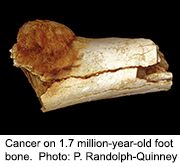Archeological Finds Push First Known Cancer Back 2 Million Years
Discoveries challenge belief that it is a modern-day disease.
Researchers report that they have unearthed the earliest evidence of bone tumors and cancers, dating back almost 2 million years.

The discoveries challenge the belief that cancer is a disease of modern life, the study authors said.
"Modern medicine tends to assume that cancers and tumors in humans are diseases caused by modern lifestyles and environments. Our studies show the origins of these diseases occurred in our ancient relatives millions of years before modern industrial societies existed," said researcher Edward Odes. He is a doctoral candidate at the University of the Witwatersrand (Wits) in Johannesburg, South Africa.
First, a 1.7-million-year-old foot bone with cancer was found at the Swartkrans cave in South Africa. The exact species is unknown, but it is a hominin, or bipedal human relative, the researchers said.
Scientists also found a benign tumor in the 2-million-year-old vertebrae of an Australopithecus sediba child found in South Africa's Malapa cave.
Until now, the oldest hominin tumor had been found in the 120,000-year-old rib of a Neanderthal, according to the researchers.
The cancer in the foot was an aggressive type called osteosarcoma, the researchers said.
"Due to its preservation, we don't know whether the single cancerous foot bone belongs to an adult or child, nor whether the cancer caused the death of this individual, but we can tell this would have affected the individual's ability to walk or run," Bernhard Zipfel said in a university news release.
Zipfel, a Wits scientist who is an expert on the foot and locomotion of early humans, added, "In short, it would have been painful."
Another member of the research team noted that the benign back tumor was a first in several ways.
"The presence of a benign tumor in Australopithecus sediba is fascinating not only because it is found in the back, an extremely rare place for such a disease to manifest in modern humans, but also because it is found in a child," Patrick Randolph-Quinney, of Wits University and the University of Central Lancashire in England, said in the news release.
"This, in fact, is the first evidence of such a disease in a young individual," he explained. Randolph-Quinney was lead author of the benign tumor paper and co-author of the cancer paper.
Source:HealthDay News
- 257 reads
Human Rights
Ringing FOWPAL’s Peace Bell for the World:Nobel Peace Prize Laureates’ Visions and Actions

Protecting the World’s Cultural Diversity for a Sustainable Future

The Peace Bell Resonates at the 27th Eurasian Economic Summit

Declaration of World Day of the Power of Hope Endorsed by People in 158 Nations

Puppet Show I International Friendship Day 2020

